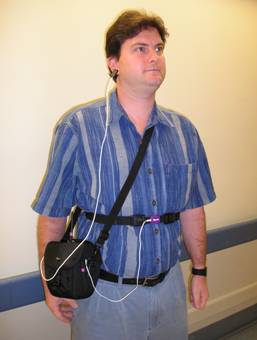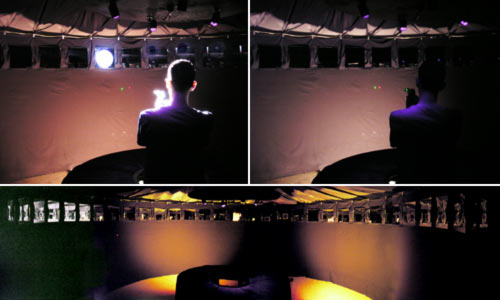Biomedical Engineering Team
Our biomedical engineering team develops software and hardware instrumentation for neurobehavioral research experiments. Responsibilities include: algorithm and interface programming, material and equipment procurement research, and construction of custom experiment apparatuses and environments. Our professional staff oversees the projects and Master's theses of students from NJIT. Safety is critical. The custom environments, apparatus and procedures are thoroughly tested for ensuring the safety of research subjects and operators while not unduly affecting the local environment. Some of our latest engineering projects containing a high degree of automation are listed and described here:
I. Ambulatory Physiological Monitoring
 For use in a variety of scientific applications, the SMBI engineering team has developed a custom ambulatory pack for the recording of a physiological suite of variables. In some types of law enforcement and military training exercises there is a need to measure a person’s physiological response. These responses may have academic value for the trainee as well as scientific value during experimental protocols. Our ambulatory pack senses the electrocardiogram, axillary body temperature, respiration, pulse oximetry, and body position. The system is battery operated and transmits the data wirelessly to a computer base station. Developed in 2005, this of one of the first devices of its kind that permitted the use of this number of variables on multiple subjects simultaneously. Figure is an early prototype
For use in a variety of scientific applications, the SMBI engineering team has developed a custom ambulatory pack for the recording of a physiological suite of variables. In some types of law enforcement and military training exercises there is a need to measure a person’s physiological response. These responses may have academic value for the trainee as well as scientific value during experimental protocols. Our ambulatory pack senses the electrocardiogram, axillary body temperature, respiration, pulse oximetry, and body position. The system is battery operated and transmits the data wirelessly to a computer base station. Developed in 2005, this of one of the first devices of its kind that permitted the use of this number of variables on multiple subjects simultaneously. Figure is an early prototype
The goal is to assess human stress and behavioral responses in both escape/avoidance and approach/avoidance conditions. Paintball gaming provided a unique opportunity to study decision making in subjects willingly exposed to tolerable, but aversive stimuli. Our engineering team developed a system capable of tracking motivated individuals' movements as they navigate an arena while being bombarded by multiple computer-automated firing arrays of markers deploying paintballs from the far end of the arena. This system spans the largest square footage covered by an infrared camera tracking system in the United States.
II. Scientific Treatment of Paintball Gaming
The goal is to assess human stress and behavioral responses in both escape/avoidance and approach/avoidance conditions. Paintball gaming provided a unique opportunity to study decision making in subjects willingly exposed to tolerable, but aversive stimuli. Our engineering team developed a system capable of tracking motivated individuals' movements as they navigate an arena while being bombarded by multiple computer-automated firing arrays of markers deploying paintballs from the far end of the arena. This system spans the largest square footage covered by an infrared camera tracking system in the United States.
III. Firing Accuracy and Interference
The military and law enforcement typically deploy distracters to reduce the targeting and firing accuracy of opponents. There is a dearth of empirical data on which to compare the effectiveness of devices and strategies. An arcade game provided standardized firing and accuracy tasks. Engineering accomplishments include: setting up light and sound distracters as well as customization and manipulation of an existing arcade game to allow for computerized control and automation. Our computer override reduced the procedural tasks required of operators and subjects.
While the arcade game presented numerous advantages -- various game scenarios and scoring -- the game itself emitted light of various intensities. The light emitted limited our ability to manipulate and control light. Therefore, the engineering team developed a custom environment to quantify interference effects in targeting and firing accuracy produced by the presence of brief, bright light and/or loud sounds. The environment provides the opportunity to manipulate the timing and positioning of a brief flash of light and/or sound while individuals participated in a targeting task. The environment consists of a cylindrical room, 16-feet in diameter, with sound and light interference sources every 10 degrees and 400 targets within 360 degrees along its wall. The engineering team fabricated a computer-automated system, achieved by development of a hardware and software system, which presented the subject with a sound or light target, preceded by a sound or light interference. The developed system enables the tracking of virtual shots from a fired simulation gun in 360 degrees of direction within a cylindrical environment.

III. Synthetic Fog
Synthetic fogs have the potential to provide obscuration with little safety risk from inhalation. Obscuration can be used as a tactical advantage to reduce visibility of adversaries or to cover the movements of friendly forces. Assessments of the effectiveness of synthetic fogs require measurement of the physical transmission of light and sound, perception of the light and sound within the fog environment and the degree that synthetic fogs inhibit movement and degrade performance. To enable such experimentation, computer control of the fog machine was desired; fog flow, density and elimination are now automated. Apparatus were developed to enable psychophysical measurement of sensory capabilities in synthetic fog. The assessment of synthetic fog also required the ability to track subject's performance in fog.
Our engineers are:
Michael T. Bergen

Michael T. Bergen
Michael Bergen is a biomedical engineer and chief of the laboratories Technology Group. He graduated with a B.S. in Electrical Engineering in 1990 and an M.S. degree in Biomedical Engineering in 2000 from the Newark College of Engineering at the New Jersey Institute of Technology. For his graduate degree, he designed, developed, and implemented a software system for the automated control and online evaluation of a classical conditioning eyeblink response experiment for use with human subjects. Besides working for the SMBI, Michael enjoys teaching biomedical engineering courses as an adjunct professor at NJIT in the Biomedical Engineering department. He began working for the New Jersey VA Health Care System in 1987.
Florence B. Chua

Florence B. Chua
Florence B. Chua is a biomedical engineer. She graduated with a B.S. in Engineering Science in 2000 and an M.S. degree in Biomedical Engineering in 2003 from the Newark College of Engineering at the New Jersey Institute of Technology. During her undergraduate curriculum, she assisted in studying the effects of spinal cord injury on the proliferation, motility, and morphology of sperm. As part of her graduate degree, she upgraded a haploscope system which presented stimuli on an oscilloscope to display instead on a computer monitor. This allowed for a wider range of stimulus types. She has completed work for the SMBI as a graduate student from 2001 through 2004, and as a contracted employee from 2004 to 2005, and as a full-time employee since then. She has participated in the Annual NorthEast Bioengineering Conference since 2003. Her professional interests include: practical applications of mathematics, algorithm development, and design.
Kunal Doshi

Florence B. Chua
Kunal Doshi is a Biomedical Engineer. He earned his M.S. degree in Biomedical Engineering from Newark College of Engineering at New Jersey Institute of Technology in December 2007. For his Master’s thesis, ‘Creating New Visualization and Human Interface Devices for Therapeutic Video Games’, he worked on interfacing Human Interface Devices (HID) such as Nintendo Wiimote and Flock of Birds with therapeutic video games and introduced 3D graphics in it. Kunal is an experienced Labview and MATLAB programmer. He is also proficient in designing electronic circuits, building proto-types and working on microcontroller and LED based projects.
